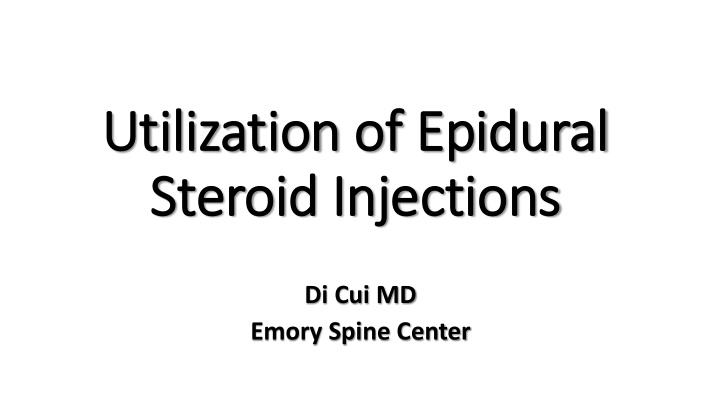



Utilization o on of Epidur dural Steroid I d Injec ections ns Di Cui MD Emory Spine Center
Utilization and trends • Primary Purpose is to decrease pain and improve function • Complements other conservative options • May help some patients avoid surgery • Buying patient time for preparation for surgery • Alternative for patient who are not surgical candidates • Utilization decreasing since 2009 More selective? Pain Physician 2017; 20:551-567
The Indications • Pain from nerve compression • Spinal stenosis I II III IV • Disc herniation • Pain with likely inflammatory basis • Favorable natural history for 75% 25% disc herniation • Not so much for spinal Favorable Response (at least 50% pain relief) - Pain Med 2011; 12:871-879 stenosis….
The Mechanism • Local Anesthetics • Sympathetic blockade Vasodilation Improved blood flow to nerves • Nociceptive C-fiber Blockade Decrease Central sensitization • Steroids • Inhibition of phospholipid arachidonic acid and reduce inflammation • Decrease Inflammation locally of injured nerves • No inferiority of non-particular steroids vs particular steroids • Epidural injection shown to be superior than oral or IM steroids Spine. 2007; 32(16): 1754-60. Can J Anesth. 2010l 67: 694-703.
The Techniques Interlaminar Transforaminal • Interlaminar • Midline • Paramidline • Transforaminal
Epidural in Spinal stenosis • Epidural Injection For Spinal Stenosis • 16 site multicenter RCT, 400 patient randomized • Central lumbar canal stenosis with pain worse in buttock/leg than low back • Interlaminar vs transforaminal • Could repeat at 3 weeks, May cross-over at 6 weeks. • Primary outcome • RMDQ at 6 weeks • 1 week pain Average Pain at 6 weeks • Secondary outcome • > 30% relief at 6 weeks • > 50% relief at 6 weeks NEJM 2014: 371(1): 11-21
Epidural in Spinal Stenosis • Both lidocaine only injection and steroid injection showed good relief • Approx. 50 % of patients received at least 30% relief at 6 weeks • Approx. 40% of patient received at least 50% relief at 6 weeks • Average pain level went from 7 to 5 • Patient who received steroids reports to be more satisfied with their relief. • 67% vs 54% • Patient with lidocaine only had a higher cross-over rate compared to group receiving steroid • 45% vs 30% NEJM 2014: 371(1): 11-21
Epidural injection and Disc Herniation • TFESI for radicular pain due to disc herniation at L4-5, L5-S1 or S1 NF • 2024 subjects • Follow up at 2 months • 70% of patients achieved 50% relief at 2 months • Up to 40% of patients had relief that lasted 12 months Pain Medicine 2013, 13: 1126-1133
Long term effect of Epidural injection RCT suggests surgical sparing effect of TFESIs • RCT of 55 patients that were operative candidates for nerve root decompression. • Transforaminal epidural injections done with bupivicaine vs. bupivicaine w/betamethasone • 28 received bupivicaine w/betamethasone; 21/28 did not proceed with operative tx at 28 months out • 27 received bupivicaine only; 9/27 opted not to proceed with operative tx at 28 months • 5 year f/u study after this showed that majority still had not undergone surgery Journal of Bone and Joint Surgery, 2000, 82-A(11): 1589-93.
The Risks • 16638 consecutive epidural injection (Pain Med. 2014; 15, 1436-1446) • Mayo Clinic, Northwestern and University of Pennsylvania • No permanent neurologic injuries reported • Compared to • >100,000 NSAIDS related hospitalization/year (AmJ Ther 2000; 7: 115-121) • 14800 opioid related death in US in a year (CDC, MMWR 2011; 60: 1-6) • Fungal Meningitis Outbreak in 2012 • Isolated care reports of spinal and brain infarcts • Most involve particulate steroids • At least 1 involving non-particulate steroids
The limitations • Criticism over long term efficacy of epidural injection • Concern about safety • Timing of injections and number of injections • Better evidence for radicular pain from disc herniation compared to central canal stenosis
Where does Epidural injection stand? Low High Safety Low High Cost Efficacy Low High Ease of Admin Low High Availability Low High
Thank you
Recommend
More recommend